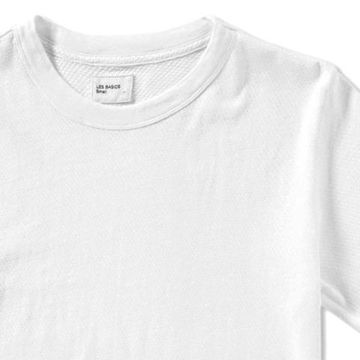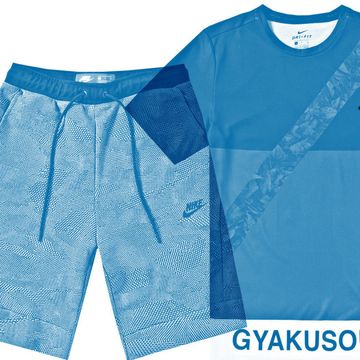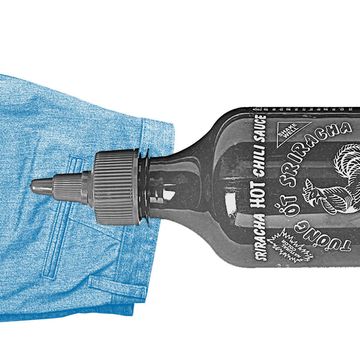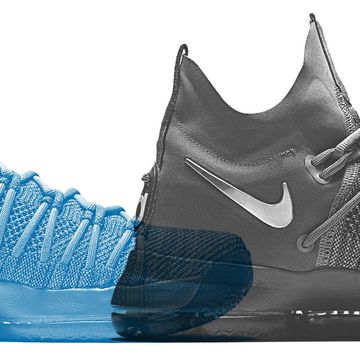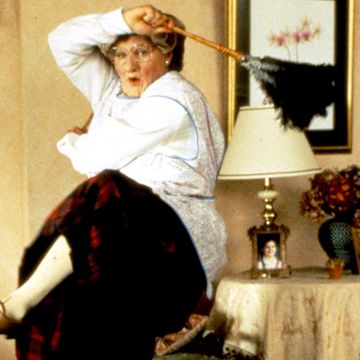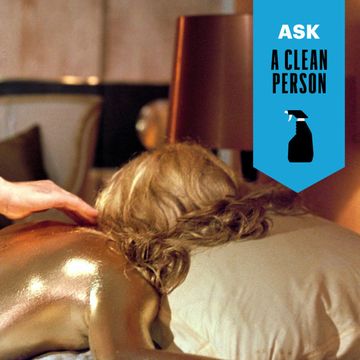Jolie Kerr is a cleaning expert and advice columnist. She'll be here every week helping to answer your filthiest questions. Are you dirty? Email her.
Stop me if you've heard this one before: I moved into a house with my girlfriend recently, and was convinced to replace the practical leather sofa with a white linen sectional out of a Better Homes and Garden magazine. Fast forward a couple months—and a couple white wine spills/muddy dog prints later—and the couch no longer has that Martha Stewart appearance anymore.
Is there any way to salvage the situation without resorting to covering the couch with quilts like it's the backseat of the car in Pulp Fiction? The couch doesn't have slip covers, so I can't just wash it.
Oddly enough, I haven't heard this one before. Well, I've heard variations on this one before, but nothing so grim as the combination of white pluslinen plus no removable slip covers. I actually thought maybe such a thing was a unicorn, something so impractical that no one would make it, much less buy it. If you need me I'll be sitting in the corner clutching my pearls and rocking back and forth. Man alive, a white linen couch without washable covers!
In fairness, it does sound like a lovely-looking couch and I'm also being overly dramatic for effect. But my heart is in the right place, because I want to take the opportunity to mention that when you're purchasing a couch, white linen or otherwise, it's a very good idea to take the care and keeping of it into account. That's not to say you shouldn't go ahead and get that white linen couch, even if you do have a dog, but you may want to opt for one that has removable covers. Which brings us nicely into the first thing I want to tell you about couches: There's a secret code among them. Except I know the secret and am going to tell you the secret today, so it's really not much of a secret.
In a perfect world, all couches would be created more or less equally when it comes to cleaning. Of course, this is not at all a perfect world, and couches like to be cleaned in different ways, which is why couch manufacturers created a cleaning code or legend. To find out what type of couch you have, check the care tag, which is usually sewn onto the underside of the seat. Once you locate the tag, here's what you need to know to interpret what you find there.
- W = Wet/water cleaning only
- S = Dry solvent cleaning only
- SW = Dry solvent and/or wet cleaning
- X = Professional cleaning or vacuuming only
The first thing to say about this is basically DO NOT BUY an X-code couch. Unless you want to be vacuuming the furniture constantly to prevent build-up from soiling the fabric and/or spending a ton on professional cleaning it's just going to be a wreck to keep up.
Somewhat similarly, S-code couches pose a challenge because locating dry solvents for home use can be tricky. Hardware and home improvement stores like Ace or Home Depot will likely carry dry solvents—oftentimes they're unbranded, so don't hesitate to ask a salesperson to help you find the right thing; if you want to order online, one brand to look for is Blue Coral Upholstery Cleaner. When using dry solvents, always follow the manufacturer's instructions, work in a well ventilated area, and consider purchasing a stiff-bristled brush to help work a small amount of the solvent into the fabric and to dislodge ground-in dirt and grime. Oh also! Dry solvents work best when used sparingly, so curb the instinct that tells us all that more cleaning solution equals a cleaner couch and use only a small amount, adding more if needed.
Okay, with all that grim news out of the way, let's talk about couches that have a W or SW code. Blessedly, it's extremely likely that most of you have one of those two types of couches. (Please only ever buy one of those two types of couches.) I'm really hoping that our Letter Writer has one of those two types of couches, because I can definitely save one of those two types of couches from a Pulp Fiction-style fate.
There are a few different routes you can go in terms of the time and monetary investment, and you should definitely take how much you spent on the couch and how long you intend to keep it into account when deciding what's best for your needs.
OK, so given that we'll start with the cheapest and easiest options: foaming or spray upholstery cleaners. Bissell makes a whole bunch of these products, Resolve also makes good ones, but honestly there are a ton of brands out there. Our friends at Good Housekeeping have a super helpful round-up of all the carpet and upholstery cleaning products they've tested that'll allow you to quickly scan their ratings and pick a good one that will fit your needs. Just like with the use of dry solvents, you may want to get a stiff-bristled upholstery brush to use in conjunction with the foam or spray cleaner.
While it's not a bad idea to keep a can or bottle of upholstery cleaner in the home to treat spills or small stains, when the entire couch is in need of cleaning, you'll be a lot better off using an upholstery cleaning machine. This is especially true if you start to notice that dreaded blue cast that's caused by dye transfer from raw or dark denim jeans, or if you have pets and or children, given the attendant grime sitch that goes along with them. In the case of the indigo dye, I should also mention that rubbing alcohol is a good stain remover to use but for larger areas isn't ideal because it will leave behind a pretty distinct smell.
A few things to note before we get into specifics: In addition to checking the care tag for the cleaning code, you'll also want to look at the fiber content; if the couch contains polyester or linen, like our Letter Writer's, steer clear of any machines that operate using steam. The steam can cause those materials to pucker in a way that will be tricky to reverse. Generally speaking, no matter what kind of couch you have or what kind of cleaner you're using, you should always do a test to be sure that it won't damage the fabric.
The great thing about upholstery cleaning machines is that they work super well and there are options for both renting or buying them. That's going to be great news for people with limited money, storage, or intention to use the machine on the regular. That last thing on the list was my nice way of saying that a lot of people buy these things and, like, never even take them out of the box. If you suspect you might be one of those people, you might want to start off renting a machine to get a feel for how they work before deciding to invest in one of your own. You can generally rent an upholstery and carpet cleaning machine from a hardware, home improvement, or grocery store. It will probably run you about $30-$50 a session. Do note that they're often billed as "carpet cleaners" but are actually multipurpose machines that can be used on upholstered furniture.
In the case of our Letter Writer, I think they should take the plunge and buy their own machine. I say that based on some clues I picked up on: It sounds like they spent a pretty penny on a really nice couch, they have a dog, and are wine drinkers. Given all that, I think an investment in the $100-$150 range will be worth it for them, and really good, portable cleaners will make a huge difference in the appearance of their furniture. Somewhat randomly, I was just in Dallas and got to see a demo of the Rug Doctor Portable Spot Cleaner, which retails for about $130. They let me, no joke, kick over a glass of red wine and then use the machine to clean it up which was, of course, thrilling for someone like me. It was probably less thrilling for that poor glass of red wine.
If you're looking to spend a little less, Bissell offers a number of different models that range from handhelds that will run you about $50 all the way up to more serious steam cleaners that can cost over $200. So! There are options, is what I'm trying to tell you. To the extent this is helpful, the Little Green Machine comes highly recommended by a pal of mine who is a car expert—I refer to him as my "car guy" because he's the one I turn to to help me out with reader questions about car care. I mention that to mention that specific model, but also to point out that these types of small cleaners can be used not just in the home, but for the car as well. Even if you have leather interior, the machine can help you to keep floor mats and headliners clean.
One last tip before I wrap all of this up: If you're on the fence about buying one of these machines, which I actually really think you should do because they are so great, seriously, try checking eBay or garage sales for a used model. My pal the car guy bought his Little Green Machine at a garage sale for about 20 bucks. Just be sure to check your couch care legend before you run out and buy one!



